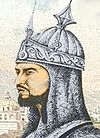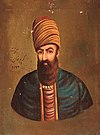List of heads of state of Iran
From Wikipedia, the free encyclopedia
This article lists the heads of state of Iran since the establishment of the modern Iranian nation-state[1] in 1501 AD.
Heads of State of Iran
The Expansive Realm of Iran (1501–1736)Safavid dynasty | |||||||
|---|---|---|---|---|---|---|---|
| No. | Name | Birth–Death | Reign start | Reign end | Dynasty | ||
| Shah of Persia | |||||||
| 1 | Shah Ismail I |  |
1487–1524 | July 1501[a] | 23 May 1524 | Safavid | |
| . | |||||||
| 2 | Shah Tahmasp I |  |
1514–1576 | 23 May 1524 | 14 May 1576 | Safavid | |
Regency:
| |||||||
| 3 | Shah Ismail II |  |
1537–1577 | 23 May 1576 | 24 November 1577 | Safavid | |
| . | |||||||
| 4 | Shah Mohammad Khodabanda | 1532–1595/96 | 11 February 1578 | 1 October 1588 | Safavid | ||
| . | |||||||
| 5 | Shah Abbas I |  |
1571–1629 | 1 October 1588 | 19 January 1629 | Safavid | |
| . | |||||||
| 6 | Shah Safi |  |
1611–1642 | 28 January 1629 | 12 May 1642 | Safavid | |
| . | |||||||
| 7 | Shah Abbas II |  |
1632–1666 | 12 May 1642 | 25 September 1666 | Safavid | |
| . | |||||||
| 8 | Shah Suleiman I |  |
1648–1694 | 1 November 1666 | 29 July 1694 | Safavid | |
| . | |||||||
| 9 | Shah Sultan Husayn |  |
1668–1726 | 6 August 1694 | 23 October 1722 |
Safavid | |
| . | |||||||
Ghilji rebellion | |||||||
| 10 | Mahmud Shah |  |
1699–1725 | 23 October 1722 | 25 April 1725 | Hotak | |
| . | |||||||
| 11 | Ashraf Shah |  |
1700–1730 | 26 April 1725 | 13 November 1729 | Hotak | |
| . | |||||||
Safavid restoration | |||||||
| 12 | Shah Tahmasp II |  |
1704–1740 | 10 November 1722 | 2 September 1732 | Safavid | |
He was crowned on 9 December 1729 after liberation of the Safavid Capital. Reigned at exile:
| |||||||
| 13 | Shah Abbas III |  |
1732–1740 | 2 September 1732 | 8 March 1736 | Safavid | |
Realm of Iran (1736–1796)Afsharid dynasty | |||||||
| 14 | Nader Shah |  |
1688–1747 | 8 March 1736 | 20 June 1747 | Afsharid | |
| . | |||||||
| 15 | Adil Shah |  |
1719–1749 | 6 July 1747 | 29 September 1748 | Afsharid | |
| . | |||||||
| 16 | Ebrahim Shah |  |
1724–1749 | 29 September 1748 | May 1749 | Afsharid | |
| . | |||||||
| 17 | Shahrokh Shah |  |
1734–1796 | May 1749 | 30 December 1749 | Afsharid | |
| Proclaimed as Shah at 30 September 1748 and one day later crowned at Mashhad. | |||||||
Second Safavid restoration | |||||||
| 18 | Suleiman II |  |
1714–1763 | 13 January 1750 | 20 March 1750 | Safavid | |
| Proclaimed after deposing and blinding of Shahrokh Shah and crowned at 14 January 1750. | |||||||
| 19 | Ismail III |  |
1733–1773 | 29 June 1750 | 1773 | Safavid | |
He was a Puppet ruler who raised to the throne by Ali Mardan Khan Bakhtiari and Karim Khan Zand as a front to legitimize their rule.[7] Regency:
| |||||||
Afsharid restoration | |||||||
| (17) | Shahrokh Shah |  |
1734–1796 | 9 May 1755 | 14 May 1796 | Afsharid | |
| . | |||||||
Zand dynasty | |||||||
| Wakil-al Raʿāyā | |||||||
| 20 | Karim Khan |  |
1705–1779 | 1773 | 1 March 1779 | Zand | |
| . | |||||||
| 21 | Abol-Fath Khan |  |
1755–1787 | 6 March 1779 | May/June 1779 | Zand | |
| He and his younger brother Mohammad Ali Khan were Co-rulers. | |||||||
| 22 | Mohammad Ali Khan |  |
1760–1779 | 6 March 1779 | 19 June 1779 | Zand | |
| He and his elder brother Abol-Fath Khan were Co-rulers until May/June 1779. | |||||||
| (21) | Abol-Fath Khan |  |
1755–1787 | 19 June 1779 | 22 August 1779 | Zand | |
| . | |||||||
| 23 | Sadeq Khan |  |
?–1781 | 22 August 1779 | 14 March 1781 | Zand | |
| . | |||||||
| 24 | Ali-Morad Khan |  |
c. 1720–1785 | 15 March 1781 | 11 February 1785 | Zand | |
| . | |||||||
| – | Bagher Shah |  |
?–1786 | 12 February 1785 | 17 February 1785 |
— | |
| After the death of Ali-Morad Khan, Bagher Khan Khorasgani Governor of Isfahan proclaimed himself as Shah and mentioned himself in the Khutbah and on coins. He was defeated from the corps of Jafar Khan.[9] | |||||||
| 25 | Jafar Khan |  |
?–1789 | 18 February 1785 | 23 January 1789 | Zand | |
| . | |||||||
| 26 | Seyd Morad Khan |  |
?–1789 | 23 January 1789 | 10 May 1789 | Zand | |
| . | |||||||
| 27 | Lotf Ali Khan |  |
c. 1769–1794 | 10 May 1789 | 20 March 1794 | Zand | |
| . | |||||||
| Shah of Iran | |||||||
| (27) | Lotf Ali Shah |  |
c. 1769–1794 | 21 March 1794 | 30 October 1794 | Zand | |
| . | |||||||
Sublime State of Persia (1796–1925) | |||||||
| 28 | Agha Mohammad Shah |  |
1742–1797 | 14 May 1796 | 17 June 1797 | Qajar | |
| Agha Mohammad decided to move his capital to the small town of Tehran on 1786.[10] He was formally crowned as Shah during spring 1796 at the Mugan plain, on his return after the conquest of Tbilisi.[11][12] | |||||||
| 29 | Fath-Ali Shah |  |
1772–1834 | 17 June 1797 | 23 October 1834 | Qajar | |
| . | |||||||
| 30 | Mohammad Shah |  |
1808–1848 | 9 November 1834 | 5 September 1848 | Qajar | |
| . | |||||||
| 31 | Naser al-Din Shah |  |
1831–1896 | 13 September 1848 | 1 May 1896 | Qajar | |
| Queen-mother Mahd-e Olia: 5 September 1848 – 1 October 1848. | |||||||
| 32 | Mozaffar ad-Din Shah |  |
1853–1907 | 2 May 1896 | 8 January 1907 | Qajar | |
| . | |||||||
| 33 | Mohammad Ali Shah |  |
1872–1925 | 8 January 1907 | 16 July 1909 |
Qajar | |
| . | |||||||
| 34 | Ahmad Shah |  |
1898–1930 | 16 July 1909 | 15 December 1925 | Qajar | |
Reigned in exile: from 2 December 1923 Regency:
| |||||||
Imperial State of Iran (1925–1979) | |||||||
| No. | Name | Birth–Death | Took office | Left office | Political Affiliation | ||
| Provisional Head of State | |||||||
| 35 | Reza Khan |  |
1878–1944 | 31 October 1925 | 15 December 1925 | Military | |
| . | |||||||
| No. | Name | Birth–Death | Took office | Left office | Dynasty | ||
| Shah of Iran | |||||||
| (35) | Reza Shah |  |
1878–1944 | 15 December 1925 | 16 September 1941 |
Pahlavi | |
| . | |||||||
| 36 | Mohammad Reza Shah |  |
1919–1980 | 16 September 1941 | 11 February 1979 | Pahlavi | |
| No. | Name | Birth–Death | Took office | Left office | Political Affiliation | ||
Islamic Republic of Iran (1979–present) | |||||||
| Leader of the Revolution | |||||||
| 37 | Ruhollah Khomeini |  |
1900-1989 | 5 February 1979 | 3 December 1979 | Independent | |
| . | |||||||
| Supreme Leader of Iran | |||||||
| (37) | Ruhollah Khomeini |  |
1900-1989 | 3 December 1979 | 3 June 1989 | Independent | |
| . | |||||||
| 38 | Ali Khamenei |  |
1939–present | 4 June 1989 | Incumbent | Independent[b] | |
| . | |||||||
Timeline

See also
Notes
- Is equivalent to Muharram 907 AH.
- Resigned from Combatant Clergy Association after selection as Supreme Leader.[15]
References
External links
Wikiwand - on
Seamless Wikipedia browsing. On steroids.
